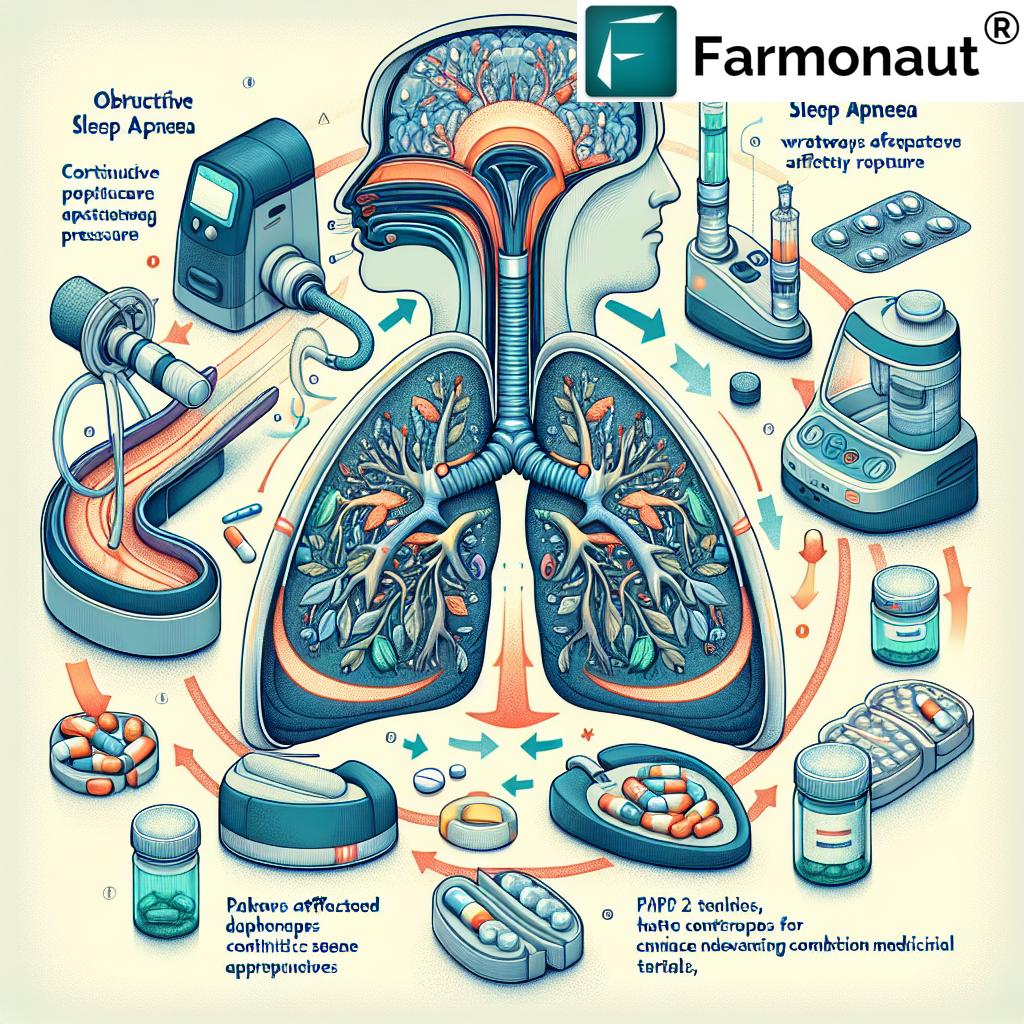Breakthrough in Obstructive Sleep Apnea Treatment: Novel Oral Drug Shows Promise in Phase 2/3 Clinical Trials
“Phase 2/3 clinical trials for a novel oral drug show promise in reducing the Apnea-Hypopnea Index in sleep apnea patients.”
In the realm of sleep medicine research, we are witnessing a significant breakthrough in obstructive sleep apnea treatment. As healthcare professionals and industry leaders, we are excited to share the latest developments in OSA clinical trials that could potentially revolutionize patient care for those suffering from this chronic sleep disorder.
Obstructive sleep apnea (OSA) affects millions of people worldwide, impacting their quality of life and overall health. Traditional treatments, while effective for many, have limitations that leave some patients seeking alternative sleep apnea treatments. Today, we’ll explore a novel oral drug for sleep apnea that’s showing remarkable promise in Phase 2/3 clinical trials.
The Dawn of a New Era in Sleep Apnea Innovation
The landscape of sleep medicine is evolving rapidly, with researchers and pharmaceutical companies working tirelessly to develop new solutions for those affected by OSA. One such innovation comes in the form of a combination medicine that targets the physiological pathways associated with sleep apnea.

This groundbreaking drug, known as IHL-42X, is currently undergoing rigorous testing in a global Phase 2/3 sleep apnea study. The clinical trial, aptly named ‘RePOSA,’ is evaluating the efficacy and safety of this innovative treatment approach.
Understanding IHL-42X: A Synergistic Approach to OSA Treatment
IHL-42X is a novel oral drug that combines two key components:
- Acetazolamide: A carbonic anhydrase inhibitor known for its effects on respiratory stimulation
- Dronabinol: A synthetic form of THC with potential benefits for sleep apnea
This unique combination is designed to address multiple aspects of OSA pathophysiology, including:
- Intermittent hypoxia (low oxygen levels)
- Hypercapnia (elevated carbon dioxide levels)
- Upper airway muscle tone
By targeting these key areas synergistically, IHL-42X aims to provide a comprehensive approach to managing obstructive sleep apnea.
Promising Results from Early Clinical Trials
The excitement surrounding IHL-42X is not unfounded. A previous Phase 2 trial conducted in Australia yielded impressive results:
- The lowest dosage achieved a 51% reduction in the Apnea-Hypopnea Index (AHI) compared to baseline
- Patients showed improved sleep quality and daytime alertness
- The drug was well-tolerated with minimal side effects
These initial findings have paved the way for the current, more extensive Phase 2/3 clinical trial.
The RePOSA Study: A Global Effort to Advance OSA Treatment
The ongoing RePOSA study represents a significant milestone in sleep apnea innovation. This global clinical trial is designed to evaluate IHL-42X in individuals who do not comply with or are intolerant of conventional treatments like Continuous Positive Airway Pressure (CPAP) therapy.
Key aspects of the RePOSA study include:
- Phase 2 segment primarily conducted in the United States
- Phase 3 segment expanding to include participants from the UK and EU
- Expected results from the U.S. portion in the first half of 2025
This comprehensive approach ensures that the drug’s efficacy and safety are thoroughly evaluated across diverse populations.
The Importance of Alternative Sleep Apnea Treatments
While CPAP therapy remains the gold standard for OSA treatment, it’s not suitable for everyone. Many patients struggle with compliance or experience side effects that make long-term use challenging. This is where alternative sleep apnea treatments like IHL-42X become crucial.
By offering a convenient oral medication, IHL-42X has the potential to improve treatment adherence and outcomes for patients who have difficulty with traditional therapies. This could lead to significant improvements in sleep apnea patient outcomes and overall quality of life.
Collaboration and Expertise: Driving Forces Behind OSA Research
The development of IHL-42X is a testament to the power of collaboration in medical research. Incannex Healthcare, the company behind this innovative drug, has assembled a team of experts to guide its clinical development.
Recently, Dr. Alison Wimms, a renowned sleep medicine researcher with over 20 years of experience, joined Incannex’s OSA Clinical Advisory Board. Her expertise in sleep medicine and research, backed by multiple advanced degrees from the University of Sydney, will undoubtedly contribute to the successful development of IHL-42X.

This collaboration between academic experts and industry leaders highlights the growing emphasis on sleep apnea innovation and the commitment to improving patient care in this field.
The Broader Impact of Sleep Apnea Research
The development of novel treatments for OSA extends beyond individual patient care. It has far-reaching implications for public health and healthcare systems worldwide. By addressing this prevalent sleep disorder more effectively, we can potentially:
- Reduce the risk of associated health complications (e.g., cardiovascular disease, diabetes)
- Improve workplace productivity and safety
- Decrease healthcare costs associated with untreated or poorly managed OSA
As we continue to make strides in sleep medicine research, the potential for positive societal impact grows exponentially.
“Obstructive Sleep Apnea affects an estimated 936 million adults worldwide, making new treatment options crucial for global health.”
Comparative Analysis: IHL-42X vs. Traditional OSA Treatments
To better understand the potential impact of IHL-42X, let’s compare it to existing OSA treatments:
| Treatment Type | Mechanism of Action | Estimated Efficacy (% reduction in AHI) | Patient Tolerance | Potential Side Effects | Estimated Treatment Duration |
|---|---|---|---|---|---|
| CPAP Therapy | Maintains airway patency with positive air pressure | 70-80% | Variable (compliance issues common) | Mask discomfort, dry mouth, nasal congestion | Nightly, ongoing |
| Oral Appliances | Repositions jaw to keep airway open | 30-50% | Generally good | Jaw pain, tooth movement, dry mouth | Nightly, ongoing |
| Surgery | Removes or alters tissue to widen airway | 50-60% (varies by procedure) | Invasive, requires recovery period | Pain, infection, changes in voice | One-time procedure, results may diminish over time |
| IHL-42X (Phase 2/3 Trial) | Targets multiple physiological pathways | 51% (based on Phase 2 results) | Well-tolerated in initial trials | Under investigation in current trials | Daily oral medication, ongoing |
This comparison highlights the potential advantages of IHL-42X, particularly in terms of convenience and patient tolerance. However, it’s important to note that the full efficacy and safety profile will be determined by the ongoing clinical trials.
The Future of Chronic Sleep Disorder Solutions
As we look to the future of sleep medicine, the development of IHL-42X represents just one facet of the ongoing revolution in chronic sleep disorder solutions. Researchers and clinicians are exploring various avenues to improve OSA treatment, including:
- Advanced neurostimulation devices
- Personalized medicine approaches based on genetic profiles
- Combination therapies that address multiple aspects of sleep disorders
These innovative approaches, coupled with advancements in diagnostic tools and patient monitoring, are paving the way for more effective, personalized treatments for OSA and other sleep disorders.
The Role of Technology in Sleep Medicine Research
Technology plays a crucial role in advancing sleep medicine research and improving patient care. From sophisticated sleep monitoring devices to AI-powered data analysis, technological innovations are enhancing our understanding of sleep disorders and facilitating the development of new treatments.
Some key technological advancements in sleep medicine include:
- Wearable sleep trackers for continuous monitoring
- Machine learning algorithms for analyzing sleep patterns
- Telemedicine platforms for remote patient care and follow-up
- Virtual reality applications for sleep therapy and relaxation
These technologies not only aid in research and development but also empower patients to take a more active role in managing their sleep health.
The Global Impact of OSA and the Need for Innovative Treatments
Obstructive sleep apnea is a global health concern, affecting millions of people across all demographics. The prevalence of OSA has been steadily increasing, driven by factors such as:
- Rising obesity rates
- Aging populations
- Increased awareness and improved diagnostic capabilities
This growing prevalence underscores the urgent need for innovative treatments like IHL-42X. By developing alternative sleep apnea treatments, we can address the diverse needs of patients worldwide and improve global health outcomes.
Challenges and Considerations in OSA Drug Development
While the development of novel oral drugs for OSA is promising, it’s important to acknowledge the challenges and considerations involved in this process:
- Regulatory hurdles and extensive clinical trial requirements
- Potential long-term side effects that may not be apparent in shorter trials
- The need for personalized treatment approaches due to the heterogeneous nature of OSA
- Balancing efficacy with safety and tolerability
Addressing these challenges requires a collaborative effort between researchers, clinicians, regulatory bodies, and patient advocacy groups.
The Importance of Patient Education and Awareness
As we advance in sleep apnea innovation, it’s crucial to emphasize the importance of patient education and awareness. Many individuals with OSA remain undiagnosed or undertreated, often due to a lack of understanding about the condition and its potential consequences.
Key areas for patient education include:
- Recognizing the symptoms of OSA
- Understanding the health risks associated with untreated sleep apnea
- Exploring available treatment options, including emerging therapies
- The importance of treatment adherence for optimal outcomes
By empowering patients with knowledge, we can improve treatment outcomes and overall quality of life for those affected by OSA.
The Economic Impact of Improved OSA Treatment
The development of more effective and tolerable OSA treatments has significant economic implications. Untreated or poorly managed sleep apnea can lead to:
- Increased healthcare costs due to associated health complications
- Reduced workplace productivity
- Higher rates of absenteeism and presenteeism
- Increased risk of workplace and motor vehicle accidents
By improving OSA treatment options, we have the potential to not only enhance individual health outcomes but also reduce the societal and economic burden of this prevalent sleep disorder.
The Role of Interdisciplinary Collaboration in OSA Research
The development of novel treatments like IHL-42X highlights the importance of interdisciplinary collaboration in advancing sleep medicine. This research brings together experts from various fields, including:
- Sleep medicine specialists
- Pharmacologists
- Neurologists
- Pulmonologists
- Data scientists and biostatisticians
By combining diverse expertise, we can approach OSA treatment from multiple angles, leading to more comprehensive and effective solutions.
Looking Ahead: The Future of OSA Management
As we eagerly await the results of the RePOSA study and continue to advance in sleep medicine research, the future of OSA management looks promising. We anticipate:
- More personalized treatment approaches based on individual patient characteristics
- Integration of advanced technologies for continuous monitoring and treatment optimization
- Combination therapies that address multiple aspects of sleep disorders
- Increased focus on prevention and early intervention strategies
These advancements have the potential to dramatically improve the lives of millions affected by OSA worldwide.
Conclusion: A New Dawn in Sleep Apnea Treatment
The development of IHL-42X and its promising performance in clinical trials marks a significant milestone in obstructive sleep apnea treatment. As we continue to explore novel oral drugs for sleep apnea and advance our understanding of this complex disorder, we move closer to providing more effective, tolerable, and accessible treatment options for OSA patients.
The ongoing Phase 2/3 sleep apnea study represents a collaborative effort to push the boundaries of sleep medicine research and improve patient outcomes. While challenges remain, the potential benefits of these innovative approaches are immense, offering hope for better sleep and improved quality of life for millions worldwide.
As we look to the future, it’s clear that the landscape of OSA management is evolving rapidly. By embracing innovation, fostering collaboration, and maintaining a patient-centered approach, we can continue to make significant strides in the field of sleep medicine.
FAQs
- What is IHL-42X, and how does it work?
IHL-42X is a novel oral drug combining acetazolamide and dronabinol, designed to target multiple physiological pathways associated with OSA, including intermittent hypoxia and hypercapnia. - How does IHL-42X compare to traditional OSA treatments like CPAP?
While CPAP remains the gold standard, IHL-42X offers a potential alternative for patients who struggle with CPAP compliance. It’s an oral medication, which may be more convenient for some patients. - When can we expect results from the current clinical trials?
Results from the U.S. portion of the RePOSA study are expected in the first half of 2025. - Is IHL-42X safe for long-term use?
The ongoing clinical trials are designed to evaluate both the efficacy and safety of IHL-42X. Long-term safety data will be crucial in determining its suitability for chronic use. - How might the development of drugs like IHL-42X impact the future of OSA treatment?
If successful, drugs like IHL-42X could provide more treatment options for OSA patients, potentially improving compliance and outcomes, especially for those who struggle with traditional therapies.
For more information on innovative agricultural solutions, visit 
Explore our mobile apps:
For developers interested in integrating agricultural data into their applications, check out our API and API Developer Docs.
Earn With Farmonaut: Affiliate Program
Earn 20% recurring commission with Farmonaut’s affiliate program by sharing your promo code and helping farmers save 10%. Onboard 10 Elite farmers monthly to earn a minimum of $148,000 annually—start now and grow your income!






